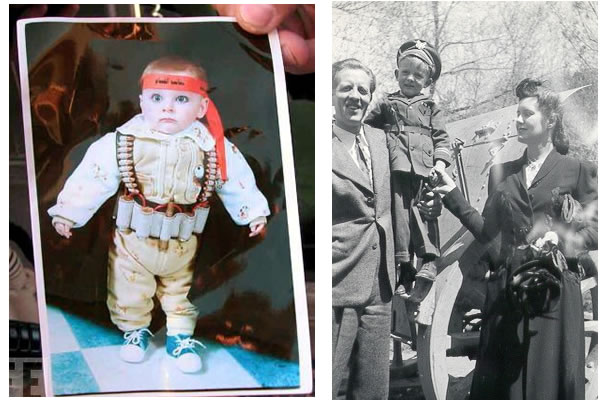“Baby Bomber Photo Shocks Israel” (BBC)
“Terror in Diapers” (Maariv)
“Dressed to Kill?” (ABC online)
The government of Israel last week induced the world’s news companies to show as many people as possible a photograph of a small Palestinian child costumed as a Hamas militant. Some voiced speculation that Israel had doctored the photo, but it was quickly acknowledged as genuine by members of the child’s family.
Intrigued, I forwarded the image to my father, who sent me a scanned photo of himself in return. Each photograph shows a very young boy elaborately costumed in military garb and presented with pride to the camera.

My father wrote:
The attached photograph was taken of me sometime in the aftermath of the Pearl Harbor attack, probably the following spring. I don't know how I came by the uniform, whether it was bought or made for me or, in either case, by whom. There must be thousands, perhaps millions of such photographs in the attics and drawers of America, photographs showing the country’s children decked out in the costumes of warriors. I would guess that I am roughly the same age, in my photo, as the Palestinian boy featured in the article you sent me. The point is, we are/were both being taught to hate. (Some, more delicate than I, might prefer to call it learning patriotism.)
There is nothing unusal here. Hating is what people do when they are under attack. I was being taught to hate the Germans and the Japanese. The little Palestinian boy is being taught to hate the Jews.
Taught to hate—that’s bad, right? Isn’t that what's wrong with terrorists, that they hate? Is that not the “moral clarity” for which our current leadership is celebrated? Is it not against the haters that we have now declared perpetual war, currently being fought in Afghanistan, Iraq, the Phillipines, Columbia, and elsewhere by American and allied soldiers? The bad guys (“axis of evil” et. al.) hate, while the good guys (Israel, us) want peace. What could be simpler.
And yet, the words of my father rang true; “Hating is what people do when they are under attack.”
Surely moral clarity, if it means anything, must begin with the answer to a simple question: Are other people the same sort of thing as me? Are my passions their passions? Do night terrors wake them, ribald jokes make them laugh? Most simply, will their sorrows compel my tears?
If the answer is no then there is nothing to discuss; treat others any which way and damn them if you wish. But if the answer is yes, then there must be a connection between these portraits deeper than resemblance.
Obviously, each forebodes violence; the one a particular violence of shattered store-fronts and burning buses and exploded human bodies, the other a more distant, less thinkable violence of fire-bombed German cities, and tens of thousands carbonized by twin atomic explosions. Yet each photo personifies the instinct and the determination of an entire people to survive. Each does violence to the innocence of the child portrayed, and each made parents proud.
But above all, each is an expression of moral clarity. For when a nation fights for its life any weapon becomes thinkable, and there is no act so terrible that it may not become an obligation.
A little over half a century ago, within the memory of many, a people called Palestinians lived on the land of their many fathers, and fought or traded with their neighbors as people are wont to do. In that place Europeans and not a few Americans now live, sharing a common destiny that they themselves have willed, and most of what was once Palestine is now Israel.
I do not know what justice might look like, much less what it might achieve, if ever it came to that blood-soaked soil. I know this, that a people does not simply go away, as even some Americans have suggested the Palestinians should do. A nation can be destroyed and its people killed or disbursed, but it does not simply vanish for convenience sake. The Jewish people themselves are a vibrant example.
Moral clarity is a fearsome thing, and our claim to owning it may be worse than simple-minded; we may be inviting lessons in moral clarity we would sooner forgo. Moral courage, on the other hand, would allow us to accept these photographs for what they are: a startling illustration of our common humanity with a desperate and wounded people.
Moral clarity detonates bombs. Moral courage signs treaties, and honors them. On that basis alone can we pretend to be the arbiters of peace. On that basis alone shall Palestinian children, and Israeli children, be comforted for the blood of their brothers and sisters. For how else will those possessed of too much moral clarity be taught to set aside their hatred, and shape their future to fit what justice may finally come?

